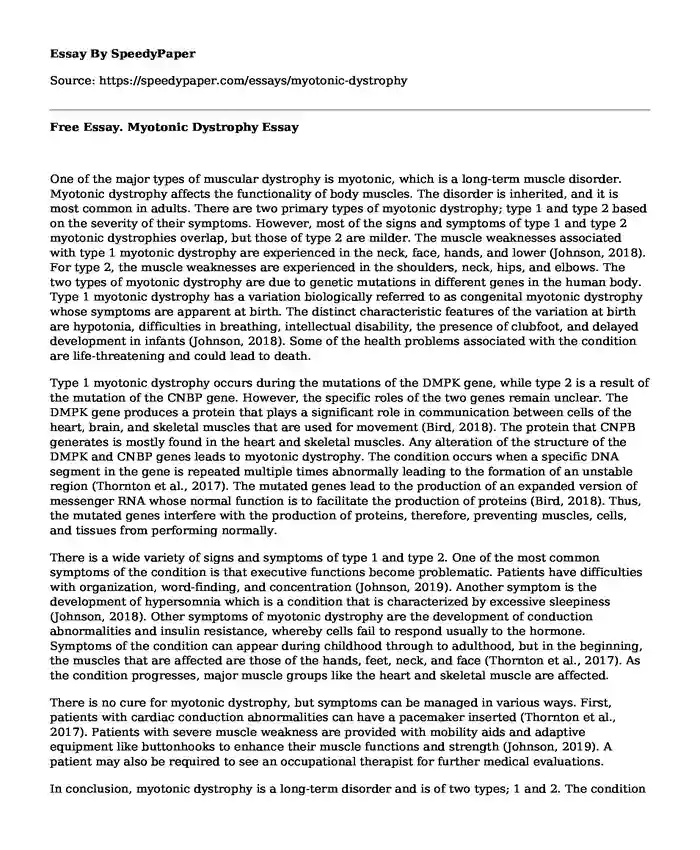
| Essay type: | Definition essays |
| Categories: | Medicine Anatomy Disorder |
| Pages: | 3 |
| Wordcount: | 661 words |
One of the major types of muscular dystrophy is myotonic, which is a long-term muscle disorder. Myotonic dystrophy affects the functionality of body muscles. The disorder is inherited, and it is most common in adults. There are two primary types of myotonic dystrophy; type 1 and type 2 based on the severity of their symptoms. However, most of the signs and symptoms of type 1 and type 2 myotonic dystrophies overlap, but those of type 2 are milder. The muscle weaknesses associated with type 1 myotonic dystrophy are experienced in the neck, face, hands, and lower (Johnson, 2018). For type 2, the muscle weaknesses are experienced in the shoulders, neck, hips, and elbows. The two types of myotonic dystrophy are due to genetic mutations in different genes in the human body. Type 1 myotonic dystrophy has a variation biologically referred to as congenital myotonic dystrophy whose symptoms are apparent at birth. The distinct characteristic features of the variation at birth are hypotonia, difficulties in breathing, intellectual disability, the presence of clubfoot, and delayed development in infants (Johnson, 2018). Some of the health problems associated with the condition are life-threatening and could lead to death.
Type 1 myotonic dystrophy occurs during the mutations of the DMPK gene, while type 2 is a result of the mutation of the CNBP gene. However, the specific roles of the two genes remain unclear. The DMPK gene produces a protein that plays a significant role in communication between cells of the heart, brain, and skeletal muscles that are used for movement (Bird, 2018). The protein that CNPB generates is mostly found in the heart and skeletal muscles. Any alteration of the structure of the DMPK and CNBP genes leads to myotonic dystrophy. The condition occurs when a specific DNA segment in the gene is repeated multiple times abnormally leading to the formation of an unstable region (Thornton et al., 2017). The mutated genes lead to the production of an expanded version of messenger RNA whose normal function is to facilitate the production of proteins (Bird, 2018). Thus, the mutated genes interfere with the production of proteins, therefore, preventing muscles, cells, and tissues from performing normally.
There is a wide variety of signs and symptoms of type 1 and type 2. One of the most common symptoms of the condition is that executive functions become problematic. Patients have difficulties with organization, word-finding, and concentration (Johnson, 2019). Another symptom is the development of hypersomnia which is a condition that is characterized by excessive sleepiness (Johnson, 2018). Other symptoms of myotonic dystrophy are the development of conduction abnormalities and insulin resistance, whereby cells fail to respond usually to the hormone. Symptoms of the condition can appear during childhood through to adulthood, but in the beginning, the muscles that are affected are those of the hands, feet, neck, and face (Thornton et al., 2017). As the condition progresses, major muscle groups like the heart and skeletal muscle are affected.
There is no cure for myotonic dystrophy, but symptoms can be managed in various ways. First, patients with cardiac conduction abnormalities can have a pacemaker inserted (Thornton et al., 2017). Patients with severe muscle weakness are provided with mobility aids and adaptive equipment like buttonhooks to enhance their muscle functions and strength (Johnson, 2019). A patient may also be required to see an occupational therapist for further medical evaluations.
In conclusion, myotonic dystrophy is a long-term disorder and is of two types; 1 and 2. The condition is genetic and has no cure. Some of the common symptoms of the condition are problematic executive functions, hypersomnia, insulin resistance, conduction abnormalities, difficulties in breathing, intellectual disability, the presence of clubfoot, and delayed development in infants.
References
Bird, T. D. (2018). Myotonic dystrophy type 1. In GeneReviews®[Internet]. University of Washington, Seattle.
Johnson, A. (2018). Myotonic dystrophy. In Pediatric Anesthesia: A Problem-Based Learning Approach (pp. 315-321). Oxford University Press.
Johnson, N. E. (2019). Myotonic muscular dystrophies. CONTINUUM: Lifelong Learning in Neurology, 25(6), 1682-1695.
Thornton, C. A., Wang, E., & Carrell, E. M. (2017). Myotonic dystrophy: approach to therapy. Current opinion in genetics & development, 44, 135-140.
Cite this page
Free Essay. Myotonic Dystrophy. (2023, Sep 28). Retrieved from https://speedypaper.net/essays/myotonic-dystrophy
Request Removal
If you are the original author of this essay and no longer wish to have it published on the SpeedyPaper website, please click below to request its removal:
- Free Essay on the US Healthcare System: Rhode Island
- Final Project Paper: Statistical Analysis Report in Mental Health
- Essay Example on Pneumonia
- Essay Example on Alternate Light Source
- Free Paper: Modernism
- Bigotry: A Legacy of the West and Its Power Over Humankind - Essay Sample
- Free Essay Sample on Respiratory Care
Popular categories




